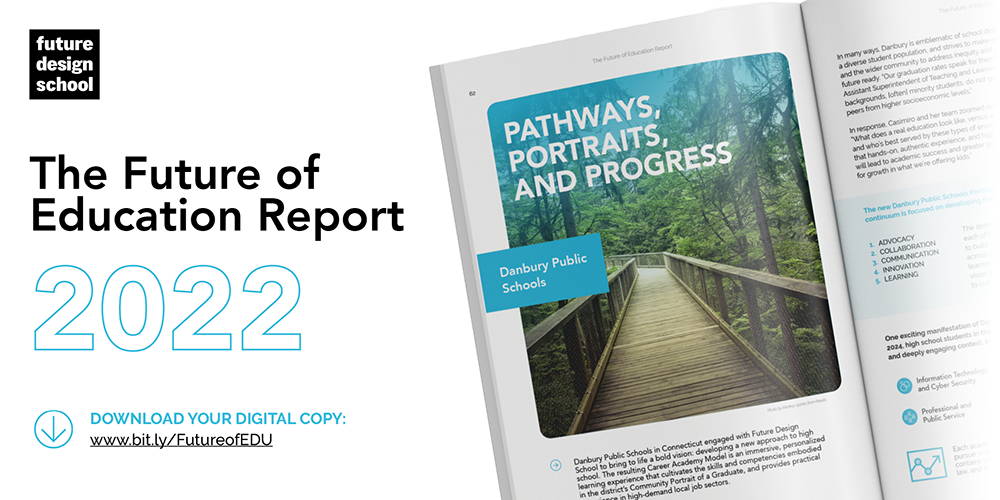Excerpted from the Future of Education Report 2022. Download your free digital copy to access the full report!
Danbury Public Schools in Connecticut engaged with Future Design School to bring to life a bold vision: developing a new approach to high school. The resulting Career Academy Model is an immersive, personalized learning experience that cultivates the skills and competencies embodied in the district’s Community Portrait of a Graduate, and provides practical experience in high-demand local job sectors.
In many ways, Danbury is emblematic of school districts across North America. It serves a diverse student population, and strives to make deep connections between its schools and the wider community to address inequity and give students the tools they need to be future ready. “Our graduation rates speak for themselves,” says Dr. Kara Quinn Casimiro, Assistant Superintendent of Teaching and Learning. “Our students from low socioeconomic backgrounds, [often] minority students, do not graduate at the same rates as their white peers from higher socioeconomic levels.”
In response, Casimiro and her team zoomed out to reexamine the purpose of education itself. “What does a real education look like, versus a student who knows how to ‘play school’ — and who’s best served by these types of environments?” she asks. “ We’re really aiming to get that hands-on, authentic experience, and high levels of student engagement, which in turn will lead to academic success and greater preparation for the future. There’s definitely room for growth in what we’re offering kids.”
The new Danbury Public Schools Portrait of a Graduate and learning continuum is focused on developing five critical attributes:
1. Advocacy
2. Collaboration
3. Communication
4. Innovation
5. Learning
The district has identified ideal states for student growth in each of these areas, and is working with Future Design School to build a progression of measurable skill development across grade bands. From there, a robust professional learning program will support teachers to implement this vision in classrooms — reimagining the learning experience to cultivate attribute development with students.
One exciting manifestation of Danbury’s new vision is its Career Academy Model. Starting in 2024, high school students in the district will build future ready attributes in a personalized and deeply engaging context, by attending one of six academies:

Each academy includes a set of industry-informed pathways for students to pursue — the Information Technology and Cyber Security academy, for example, contains pathways devoted to teaching and education, culinary arts, justice and law, and Reserve Officers’ Training Corps leadership.
While some pathways in Danbury’s new Academy model lead students toward postsecondary education, some lead directly to apprenticeships or the workplace — a need identified through conversations with the students themselves. “There was a lot of student voice that started to identify areas of need and growth in our system,” says Melissa Nadeau, STEM Curriculum Administrator at Danbury. “They felt that they needed more guidance on what they can do with their lives after high school that did not just involve college, and that was pretty powerful.”
"We’ve built a lot of excitement, and we’ve included board members in a way we haven’t really done before. We’ve really engaged them in this process, and that’s one of the ways we used Future Design School. I need 12 board members who can go out in the community, and rub elbows with everybody that they can. Future Design School helped us bring people to the same spot of understanding, and to have them have some stake in the game and feel like they have ownership of it — that they’ve come to this conclusion that this is the right thing to do for kids."
DR. KARA QUINN CASIMIRO
Assistant Superintendent of Teaching and Learning
Danbury Public Schools
The consultation process in developing the Portrait and the Academy model was broad and deep. Students, parents, teachers, school and district leaders, and local job providers were all brought to the table, leading to a fulsome plan that was met with wide support and enthusiasm. “There was no pushback, and that’s because people heard their voice in our plan,” Casimiro explains. “It was planned by design to address everyone’s concerns and hopes and dreams, so that when we presented it, it was the perfect plan because everyone’s voices were reflected.”

Ensuring teacher and student engagement in this major change was particularly important. To that end, Danbury will be leveraging technology to connect artifacts from personalized learning, skill development metrics, academic progress, and student self reflections. Teachers will have access to all of this information, giving them a wider view of how students are progressing — and students themselves will also track their own progress and accomplishments.
As they move through school, students will develop a demonstrable record of their accomplishments, which they can use in applications to higher education and to showcase their skills to potential employers. Identifying and acting on the need for this deep, personalized tool to track student progress is a powerful example of how the Danbury leadership team is connecting more deeply with all stakeholders in their midst — and why it’s so valuable to engage in a facilitated process to bring those voices to the table. “We are the owners of a vast amount of knowledge for the context with which we work, and there’s power in that, but you need to break away from the noise of your own perception,” Nadeau says. “That’s why collaborating with Future Design School was important: it takes away your own bias that you bring to the table and really provides an equitable system to bring out ideas from others that maybe wouldn’t have had a voice.”
Engaging with area industries was particularly important and fruitful — especially given available funding in the district. “In Connecticut, out of 169 towns, we are at the bottom in terms of pure, per-pupil funding,” Casimiro says. “What that means is that we educate children at the bare minimum of cost. But what’s interesting is that, with the work that we have done to this point, we have talked to more local partners: the health industry; our local hospital; some manufacturing companies. They are begging to come to the table to find ways to support us to get this off the ground.” As a result of this engagement, both the Portrait and Academy model Danbury is implementing is informed by local industry and reflects the future ready skills they’re seeking from current and future employees.

“What Future Design School facilitated is the beginning of hope for this community. It represents change for a community whose future depends on the education system.”
MELISSA NADEAU
STEM Curriculum Administrator
Danbury Public Schools
And as for concerns about academic rigor in Academy pathways, Nadeau notes that authenticity and an interdisciplinary approach help reinforce academic concepts in a relatable and personalized way. “There’s no reason why kids can’t go through an inquiry process within a culinary course to explore why some breads rise, and some breads do not, and talk about how to bake the perfect loaf of bread, based on certain criteria,” she points out. “That is exactly what we would do in a science classroom, but just applied in a culinary sense — and I would argue that many students, who are sometimes not engaged in the pure application of a science or mathematical principles, will find a lot of worth in it when they can see themselves in their own student choice of learning in a culinary atmosphere. They would find more value in that lesson and allow them to make more connections between school, community, and work.”
The transformations that Casimiro, Nadeau, and the Danbury team are making are poised to make a profound and lasting impact. “When I look out my window, I think about the statistic that 40% of my neighbors may not graduate from high school,” says Nadeau, who grew up in Danbury. “What Future Design School facilitated is the beginning of hope for this community. It represents change for a community whose future depends on the education system.”
This article originally appeared in the Future of Education Report 2022. Download your free digital copy for expert insight into the emerging trends shaping the education landscape.
Learn more: https://learn.futuredesignschool.com/pages/futureofeducation

